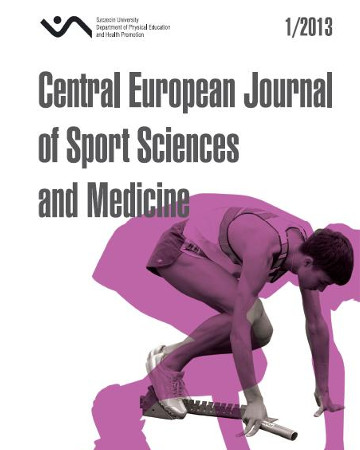
ISSN: 2300-9705
eISSN: 2353-2807
OAI




Issue archive /
Vol. 1, No. 1/2013
Chosen induvidual factors of adolescents' physical development in their leisure time
| Authors: |
Karol
Görner
Institute of Humanities, Matej Bel University, Banska Bystrica Adam Jurczak Institute of Social Sciences, University School of Physical Education, Cracow Robert Makuch Institute of Physical Culture and Pedagogy, Technical University, Radom Dariusz Mucha Institute of Human Physiology, University School of Physical Education, Cracow Michał Spieszny Institute of Sports, University School of Physical Education, Cracow |
| Keywords: | adolescents motor activity needs motor skills physical activity physical fitness |
| Data publikacji całości: | 2013 |
| Page range: | 7 (31-37) |
Abstract
The aim of the research was to diagnose chosen individual factors of adolescents’ physical development (motor skills, physical fitness, motor activity needs) and their influence on their actual level of physical activity in their leisure time. The subjects of the research were students of Cracow’s junior high schools. The probability sample of 295 girls and 329 boys were examined. The method used was a survey. The results of the examinations showed that the chosen individual factors had an influence on the actual level of physical activity in their leisure time. The boys’ motor skills (in contrast with the rest of the factors) correlated the least with the increase of the actual level of physical activity in leisure time, and in case of the girls, they did not correlate at all. Youngsters’ individual predispositions to undertake physical activity in their free time were at a medium-high level. Nevertheless, their internalization did not take place because more than a half of the subjects undertook physical activities at a low level (51.0%) or not at all (7.4%).
Download file
Article file
Bibliography
| 1. | Borecka-Biernat D., Węgłowska-Rzepa K. Zachowanie młodzieży w sytuacji kontaktu społecznego. Wydawnictwo Uniwersytetu Wrocławskiego, Wrocław 2000. |
| 2. | Denek K. Pedagogiczne aspekty czasu wolnego. Lider. 2006;12:8–14. |
| 3. | Grabowski H. Teoria fizycznej edukacji. WSiP, Warszawa 1997. |
| 4. | Haggera M.S., Chatzisantisa N, Biddle'a S.J.H. The influence of self-efficacy and past behaviour on the physical activity intentions of young people. Journal of Sports Sciences. 2001;19(9):711–725. |
| 5. | Hausenblas H.A., Carron A.V., Mack D.E. Applied benefits of the education model. Journal of Physical Education, Recreation and Dance. 1997;4:36-51. |
| 6. | Kulas H. Samoocena młodzieży. Wydawnictwo Szkolne i Pedagogiczne, Warszawa 1986. |
| 7. | Sas-Nowosielski K. 2003. Wychowanie do aktywności fizycznej. AWF, Katowice. |
| 8. | Winiarski R.W. Aktywność sportowa młodzieży. Geneza - struktura - uwarunkowania. Wydawnictwo Monograficzne AWF, Kraków. 1995;66. |
| 9. | Witkowski T. Psychomanipulacje: jak je rozpoznawać i jak sobie z nimi radzić. Biblioteka Moderatora, Taszów 2004. |
| 10. | Zuchora K. Wychowanie fizyczne naszych dni. Sport i Turystyka, Warszawa 1974. |
| 11. | Żiżka-Salamon D., Winiarski R. Wartości ciała uznawane i realizowane przez młodzież szkół krakowskich. Wychowanie Fizyczne i Sport. 2002;46(4):525–537. |